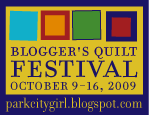
I iron it in half, turn it, and iron another crease so I have a four squares ironed into my fabric. Then, I iron creases from corner to corner. This gives me a guide for placement of the appliqué pieces.
You may have noticed that all my leaves aren't perfectly symmetrical and they're all different fabrics. I like the organic look -- no two leaves are ever the same in real life either. And I'm relieved from having to make 12 exactly perfectly matching leaves.
I traced the design from the pattern onto baking parchment. I line it up with the ironed-in creases, then place my pieces with tweezers. I have these nifty little appliqué pins to hold them in place while I stitch. They're nice because they're so tiny, the thread doesn't catch them when I'm sewing.
I use a small needle and thread that matches the appliqué, not the background. I bury the knot under the appliqué, then do a blind stitch catching the fold of the appliqué.
To make the stems, I have this cool little pen. It has a "magic" potion in it (don't know what it is but I really hope it's not something that will make my quilt rot in 20 years).
 I cut the bias strip -- the finished piece was a little larger than a quarter inch, so I cut them at 3/4 of an inch.
I cut the bias strip -- the finished piece was a little larger than a quarter inch, so I cut them at 3/4 of an inch. Then I put my ruler down, leaving a scant quarter inch and "marked" it with the pen. The liquid makes it easy to fold, then press with a hot iron. I turned it and did the other side.
This pen is also useful for turning edges on labels, or anything else. The wet line turns really easily. And I can make bias strips any size -- I'm not limited to the sizes the strip-makers make.
Next: Those *&#@;$!!! little circles.































2 comments:
Never seen a pen that does that! Clever.
Nice! BTW, the YLI silk thread is fabulous for applique. It's so fine and slips through the fabric like butta!! I used to like needleturn applique. Crazy, yes? Well not the little teeny circles, but all the rest.
Post a Comment